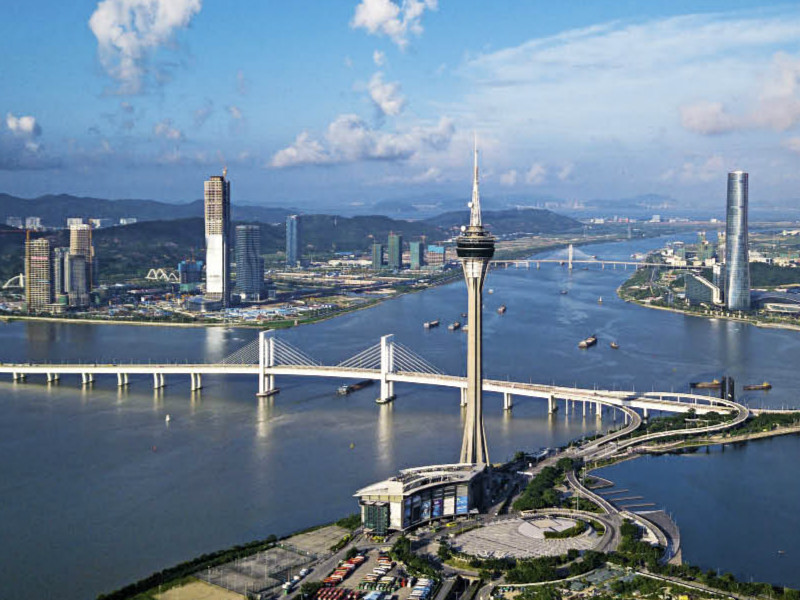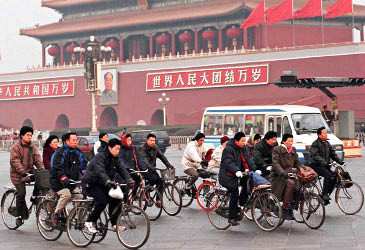The Guangdong-Hong Kong-Macao Greater Bay Area promises to become an important engine for China’s economic development as a frontier land of the country’s reform and opening-up.
Over the past 70 years, China has been progressing at a high velocity but peacefully and harmoniously. Having undergone 100 years of turmoil since the Opium War, Chairman Mao announced the establishment of the People’s Republic of China on October 1, 1949. Following the dawning of that monumental day, the country took the world by storm setting new standards of inclusive development with modernity, people-centric policies, and global governance.
The French emperor Napoleon Bonaparte once said, “China is a sleeping giant. Let her sleep, for when she wakes she will move the world.” That prophecy has thus far proven true. China is one of the few nations on Earth that has made a mark and established itself as one of the most resilient powers in history. It reigned supreme throughout various dynasties, but then a few centuries ago lost its shine. Once again it has risen in recent decades. China made miraculous gains since its founding and has been multiplying these gains under the leadership of Chinese President Xi Jinping.
Few believe that from 1949 to 1978, China was isolated and had meager ambition to develop on the international stage. During this period, Chairman Mao Zedong pulled the country together and initiated the first necessary steps towards development: building roads, railways, power stations, and reservoirs, laying the foundation of China’s infrastructure. If such a system had not been put in place, modern industrialization would not have evolved. More importantly, Chairman Mao developed a national culture of possibility, changing the mindset from gloom and oppression to optimism. Without the enthusiasm to develop China as a modern nation, nothing much would have happened.
After the Third Plenary Session of the 11th Central Committee of the Communist Party of China, Deng Xiaoping, the new Chinese leader, outlined the open-door policy and kicked off reform in 1978. China decided to achieve economic growth through the active introduction of foreign capital and technology while maintaining its commitment to socialism with Chinese characteristics.
The government subsequently opened up a number of areas for foreign investment, including the special economic zones, open coastal cities, economic and technology development zones, and high-tech industrial development zones. The establishment of these zones provided the trigger for massive inflows of foreign investment, as well as all-round development. At the same time, China promoted its socialist market economy concept. The changes brought an entrepreneurial boom that resulted in the emergence of huge numbers of entrepreneurs and businesses in China.
Rapid economic growth was accompanied by a rise in per capita GDP. In 1998, China’s per capita disposable income, though still only about US $770, was 14 times higher than that in 1980. Therefore, it seems reasonable to conclude that Deng Xiaoping’s first goal, which was to improve the economic status of the people, had been accomplished. In the Xi Jinping era, the momentum has been maintained and sped up, helping ramp up GDP and growth. In 2018, China’s GDP hit RMB 90 trillion (about US $13.6 trillion), and its GDP per capita stood at US $9,777, almost 10 times that in 2001 (US $1,000).
During the past 70 years, China has launched many programs to eradicate poverty, especially in rural areas. As a result, poverty is going to breathe its last in 2020. Between 2013 and 2018, the number of Chinese living in poverty in the countryside was curtailed by 82.39 million. China has experienced rapid income and consumption growth in rural areas over the past 70 years, according to a report from the National Bureau of Statistics.
In 2018, China’s rural per capita disposable income stood at RMB 14,617 (about US $2,088), which has been nearly a 40 fold increment over the figure in 1949. The incidence of rural poverty also fell from 10.2 percent at the end of 2012 to 1.7 percent at the end of 2018. The country’s urban-rural income gap has shrunk remarkably, with the ratio of per capita disposable income for urban residents to that of rural residents hitting 2.69 in 2018, 0.64 lower than that in 1956. Household consumption in rural areas also increased, with the average ownership of cars, computers, and cell phones per 100 households reaching 22.3, 26.9, and 257, respectively, in 2018.

The Guangdong-Hong Kong-Macao Greater Bay Area promises to become an important engine for China’s economic development as a frontier land of the country’s reform and opening-up.
Globalization has been a powerful force for economic growth. Research from the McKinsey Global Institute (MGI) finds that the movement of goods, services, finance, data, and people across borders adds to GDP and fuels productivity growth — and China has been one of the world’s major beneficiaries because it designed a very efficient economic management system. The nation’s period of double-digit GDP growth in the mid-2000s was fueled by even faster growth in the flow of goods in and out of China. As exports surged from just US $257 billion in 2000 to US $2.4 trillion in 2016, China became the world’s top exporter.
China’s trade growth in 2018 reached 9.7 percent compared to a world growth rate of 3.0 percent. Over the past several decades, Chinese trade has expanded at a breakneck pace. In 1995, the value of China’s imports and exports of goods totaled US $280.9 billion or 3 percent of global trade. By 2017, its total trade in goods had jumped to US $4.1 trillion or 12.4 percent of global trade.
With reforms and opening-up, China has achieved rapid development and bolstered its credentials as a leader on the global stage. China’s Belt and Road Initiative has changed all dynamics of development and underpinned globalization at the stage when protectionism has been rearing its head.
BRI is now making its best strides as trade among BRI countries has been blossoming. China’s trade with countries participating in the Belt and Road Initiative (BRI) posted robust growth in the first half of this year. Trade with BRI countries totaled RMB 4.24 trillion (US $617.5 billion) during this period, up 9.7 percent year-on-year and outpaced the overall trade growth rate of the country in the first half of the year, according to the General Administration of Customs (GAC).
Green development is a new goal of the Chinese government. China has unveiled a series of measures to strengthen green and environmental industries, including quickening the pace of upgrading thermal power, steel and other industries to achieve ultra-low emissions and enforcing upgrades in heavily polluting sectors to achieve compliance with standards. The country plans to reduce sulfur dioxide and nitrogen oxide emissions by 3 percent in 2019, while making continuous efforts to reduce the density of PM2.5, a major particle pollutant, in key locations, including the Beijing-Tianjin-Hebei area and the Yangtze River Delta.

In the 1990s, bikes are the dominant transportation means in Beijing.
As for water and soil pollution control, the target for the year is to achieve a 2 percent drop in both chemical oxygen demand and ammonia nitrogen emissions.
After 70 years, China is making a big splash in the education sector, and China is becoming a lucrative destination for foreign students. The number of foreigners enrolled in Chinese universities has increased almost tenfold from 52,150 in 2000 to more than 500,000 last year. China is now Asia’s top destination for international students, with the majority arriving from South Korea, Thailand, Pakistan, and the United States, according to the Ministry of Education.
A 2009 poll of overseas students at Peking University found 82.7 percent had chosen to study in the country because they wanted a career related to China, while a survey taken at a 2016 job fair organized by the ministry’s Chinese Service Center for Scholarly Exchange and Peking University also found 95 percent of international students wanted to find a job in China.
YASIR HABIB KHAN is president of the Institute of International Relations and Media Research (IRMR). He is also a senior journalist writing for Global Times, China Economic Net, CRIOnline, Geo TV, The Nation, and Daily Times.